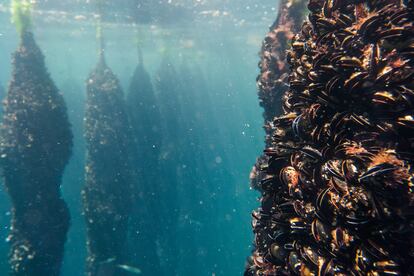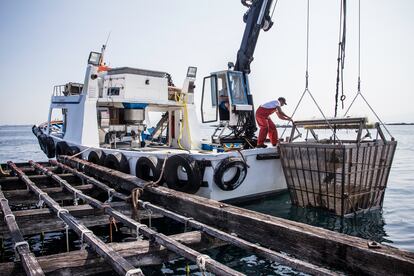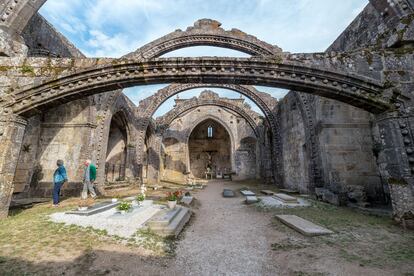In the heart of the Arosa estuary, Galicia displays one of its most dazzling jewels: Cambados. Capital of Albariño and kilometre zero of mussels, the superfood of the sea, its carefully preserved historic complex, its stately manor houses and its excellent gastronomy make this Pontevedra municipality located in the Val do Salnés one of the most attractive destinations in the Rías Baixas.
“The jar of roiba is passed from hand to hand of Albariño, and while the rain falls and the wind shakes the whole house (…)”. This is how Ramón Cabanillas, known as the Albariño wine, sang about it. Poet of Race and one of the most illustrious authors of Galician literature. Originally from Cambados, he used his poems to serve Galicianism. It is not surprising that the captivating beauty of this land bathed by the Arosa estuary, with its 230 square kilometers the largest in Galicia and Spain, It also inspired the verses of other illustrious writers such as Ramón María del Valle-Inclán, originally from Vilanova de Arousa, and Emilia Pardo Bazán. Cambados was declared a Site of Cultural Interest in 2001 and proudly boasts of being one of the most important wine regions in Spain.
The history of this region cannot be understood without its close connection with wines made from the white Albariño grape and its ancestral winemaking tradition linked to the Rías Baixas Denomination of Origin. Lovers of fresh, aromatic and fruity wines will need to spend hours exploring the 21 wineries that form part of the Cambados wine route, six of them within the town centre. A dream landscape dotted with vineyards and century-old wineries.
One of the oldest and most popular internationally is the Gerardo Mendez Wineryfounded in 1973 in the town of Meaño, Pontevedra. Its flagship product, Do Ferreiro Cepas Vellas, was the winery’s first white wine and one of the pioneers of the DO Rías Baixas, and came from an inimitable vineyard that is now more than 200 years old. In the words of Gerardo himself: “With old strains We have managed to rescue the pure essence of the old Albariño.” They currently have seven references. The winery, which was joined by his son Manuel, was one of the first to register with the Regulatory Council of the Rías Baixas Designation of Origin. In 2019, the magazine Wine & Spirits He classified it as one of the best in the world and the special gastro of The New York Times December 2023 included Do Ferreiro on the list of the best wines in the world.
Cambados tastes like the sea
The wine spirit and the taste for Galician gastronomy can be felt in every corner of this town with a long culinary tradition. On its main street, Calle Real, there are plenty of tapas bars and restaurants serving the typical octopus. the fairbraised scallops, scallops, cod, Padrón peppers, razor clams, oysters and exquisite garden produce, among many other delicacies. The Arosa estuary becomes a natural supermarket that supplies Cambadese people with fresh fish and seafood on a daily basis, especially scallops, as it is the only port in Galicia where the extraction of this precious mollusk is permitted. All this, washed down with excellent Albariños from the land, turns this territory of Pontevedra into a first-class gastronomic temple. Devotees of the god Bacchus have an annual appointment in the allegorical Albariño Festival, one of the oldest food and wine festivals in Spain (since 1953) that takes place the first weekend of August in this beautiful town in Pontevedra.
Another of Cambados’ star products is the mussel. This enclave is considered the zero kilometre of this superfood from the sea. Once again, the Arosa estuary is the supplier of this mollusc with excellent nutritional properties and with which a wide variety of irresistible dishes are prepared. In just a few kilocalories, it provides numerous quality proteins, all the essential amino acids, omega-3, vitamin B12 and is a source of minerals such as zinc, iron or selenium.

Fans of ancient seafaring trades and healthy, balanced eating have the option, upon reservation, of visiting the modern fish factory that Aguinamar has owned since 2017 on the banks of the Arosa estuary. There, fresh products such as mussels are produced in a sustainable manner, obtained directly from the estuary. The production processes rely on innovative methods whose impact on the final quality of the product is minimal, as well as energy savings and resource optimisation. They have their own local batters and apply extensive aquaculture. Did you know that the rafts create a microhabitat where a multitude of marine species take refuge or that the mussel acts as a CO2 collector, thus reducing the carbon footprint?
Sailing the waters of the Arosa estuary in a typical fishing boat, I was able to see the mussel rafts and discover the ins and outs of a trade typically rooted in the life of this land of Celts and brave sailors: the mussel rafters or bats. This is, without a doubt, one of the most unusual and typically Galician activities that Cambados offers. Mussel farming in Galicia dates back to 1946 – in total, around 250,000 tonnes are produced annually in the Galician estuaries. The rafts are flat floating structures with striking colours made from ecological paint, mostly built with eucalyptus wood on the top (the most modern structures are made of concrete). In the submerged area, there are ropes where the mussels adhere, with a
maximum length of 12 metres. The mussel larvae attach to the rope and from there the seed for the next year’s crop emerges. Approximately 20 kilos of adult mussels are obtained for each metre of rope. Cultivation in rafts is something so peculiar to the Galician estuaries that it has become part of Galicia’s heritage.

Stately manor houses and historical heritage
“If it has a dovecote, a chapel and a cypress tree, it is a manor house.” This is the saying of a well-known Galician proverb that refers to these typical Galician palaces, most of which were built between the 17th and 19th centuries. Admiring the enormous dimensions of these architectural gems, getting lost in their gardens or contemplating the stately coats of arms is an unmissable opportunity to soak up the maxia from history Galician. Cambados boasts of being one of the places with the largest number of stately manor houses. Among some of those that can be visited, the one in the Martin Codax Winery, Montesacro —also known as the Pazo de Santo Tomé—, Fefinans either Bazancurrent Cambados inn.
The attractive monumental historical-artistic heritage of this seaside town is another of its great attractions. In addition to enjoying its delicious cuisine, wine tourism, visiting the rafts or, if the weather permits, diving into the icy waters of its paradisiacal beaches, getting lost in the streets of its historic center is a must. A walk that runs through cobbled streets, beautiful squares and crosses where they rest the ruins of Santa Mariña de Dozothe Church of Saint Benedictthe Town Hall, the squares of Ramón Cabanillas and Alfredo Brañas, the Fajardo Manor Housethe House of the Cunchas (the house of shells), the Fariña House or the Ethnographic and Wine Museum.

You cannot leave Cambados without walking along its extensive seafront promenade, which is about two kilometres long and extends between the Molino de Mareas de A Seca and the fishing district of San Tomé. Any time is ideal to immerse yourself in this seafaring universe and contemplate a priceless postcard of the Arosa estuary, the island of La Toja, the Tower of San Sadurniño, the rafts, A Illa de Arousa and even the O Grove peninsula.
This is an exciting land where the witches and the Trasnos They conjure at will so that magic becomes a fundamental ingredient that feeds the traveller’s soul. Cambados and Val do Salnés are solemn ambassadors of this ancient land of Celtic roots with a taste of the sea and Albariño, where famous authors of Spanish and Galician literature lived. An ode to the quality of life seasoned with ingredients as appetising as melancholic homesickness and the spell of ancestral incantations.
Subscribe here to the The Traveler’s newsletter and find inspiration for your next trips on our accounts Facebook, X and Instagram.
#Cambados #mustsees #Albariño #kilometre #mussels #country #houses #poets